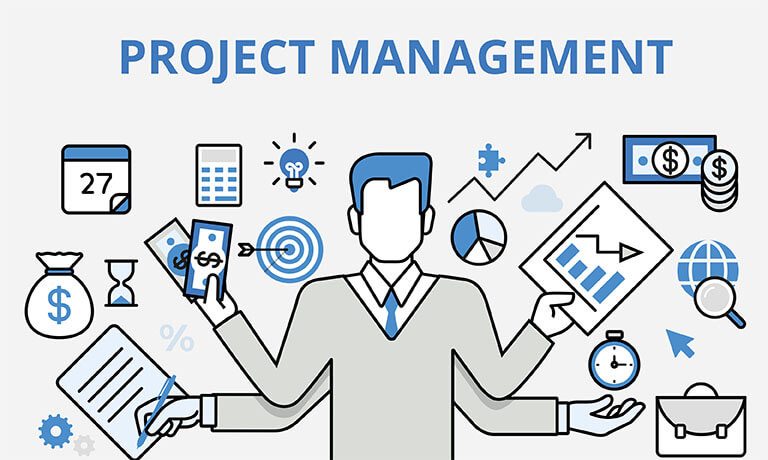
The Project Management Office (PMO) offers Project & Program Management, Training & Coaching, and Consultation for project management. We provide qualified Program and Project Manager resources responsible for planning, managing, and executing approved projects, using industry best practices. We deliver value by providing necessary capabilities to meet sponsor and stakeholder expectations for project success. We also provide training to the company and people on how to use project and program management processes and practices effectively.
What does the PMO offer?
The PMO is a service organization created to support the successful implementation of technology projects at UT Arlington.
THE PURPOSE OF THE PMO:
THE PMO IS RESPONSIBLE FOR:
OIT Project Managers Will:
The UTA PMO frequently assists with projects that involve:
A project is a temporary endeavor undertaken to create a unique product, service or result. A project is temporary in that it has a defined beginning and end in time, and therefore defined scope and resources. A project is unique in that it is not a routine operation, but a specific set of operations designed to accomplish a singular goal.
Accomplished by shared resources often only available during the project life cycle
Usually involve cross-functional teamwork
Uncertainty and risk are involved
Outcome not fully known
Changes the way the business operates
Has specific deliverables, timelines and resource constraints
Significant communication efforts
Formal training will be needed
End users will undergo some form of change or disruption
If you have an idea that you would like to submit for project consideration, please enter your information into ServiceNow or contact the Project Management Office at oit-pmo@uta.edu.
OIT PMO offers a framework containing the basic templates, phases and processes. If you want learn more about the different phases and activities related to each phase, please see our PMO Project Lifecycle.
If you’re simply looking for some information on project management activities and associated templates to get started with your project, please see our Full List of Project Management Templates.
PMO has a series of training modules that explain the project lifecycle from initiation to completion, describe how to use the different project management tools and templates available in the PMO, and introduce the key skills needed to succeed in the Project Manager role. To learn more, please register to access the PMO Training Course in Canvas, which includes video commentary and links to the PMO LinkedIn Learning curative course. Once you register, you will be able to access the direct links to the training videos listed in the Tools and Templates page.
The Project Management Office (PMO) provides a listing of the tools and templates used throughout the various phases of the project lifecycle. In order to view a sequential listing of the key activities and deliverables in each project phase, please visit the PMO Project Lifecycle.
Please register to access the PMO Training Course in Canvas, which includes video commentary to some of the commonly used project templates. Once you register for the course you will be able to access the direct links to the training videos below.
The Project Management Center of Excellence can assist, coach and educate project manager roles across the organization with their initiatives to plan and complete their projects effectively using project management best practices.
If you require support from the Project Management Center of Excellence, please fill out the Project Management Center of Excellence - Requester Form.
| Templates | Description | When to use |
|
Project Template Checklist
|
Project Management checklist displays the required project documentation needed for each of the stages in the project life cycle. This is based on the five distinct project categories: Strategic, Operational, Enhancement, Innovation, and Regulatory.
|
|
| Project Template Checklist | ||
|
Project Management Detailed Guide Checklist |
The Project Management Detailed Guide Checklist is used to assist project managers to initiate, plan, execute, and close a project. It lists the key activities that project managers should focus on when managing a project from beginning to end. This is based on the five distinct project categories: Strategic, Operational, Enhancement, Innovation, and Regulatory.
|
|
| Project Management Detailed Guide Checklist | ||
|
Project Roles and Responsibilities |
The Project Roles and Responsibilities document specifies defined roles to each member or group of the project team |
|
| Project Roles and Responsibilities | ||
|
Project Type Definition |
The Project Type Definitions document serves as a reference guide for anyone involved in submitting, reviewing, or managing projects at UTA. |
|
| Project Type Definition | ||
|
Initiative Request |
The Initiative Request Form provides a purpose and overview of the project that is being requested for OIT projects. |
|
| Initiative Request | ||
|
Project Management Services and Training request |
ServiceNow request for project management consulting or customized training on project management best practices, scheduling, lifecycle, and tools. |
|
| Project Management ServiceNow request | ||
|
Business Case |
The Business Case is a strategic planning tool that outlines the purpose, goal(s) and benefits of the proposed initiative to campus decision-makers. |
|
| Business Case Template & Business Case Training Video | ||
|
Status Report Guidelines |
The main purpose of the Project Status Report is to inform your project team, sponsors, and stakeholder of the progress of the project, any challenges, and maintain transparency.
|
|
|
Business Requirements Document Template |
A business requirement is a description of the features and functions of a product that satisfies a want or need enabling people to do, know, operate, or have something new or in a new way. Business requirements document also emphasizes on the needs and expectations of the customer. In simpler terms, BRD indicates what the business wants to achieve. |
|
| BRD Template | ||
|
Project Meeting Agenda |
The Project Meeting Agenda is a formal template that can be used to clearly outline all components for a successful and effective meeting. |
|
| Project Meeting Agenda Template | ||
|
Project Charter |
The Project Charter template provides a high-level overview of what the project is, why it is necessary, and the details it entails. |
|
| Project Charter Template , Project Charter Lite & Project Charter Training Video | ||
|
Project Kickoff Meeting Agenda |
The purpose of the Project Kickoff meeting is to ensure that stakeholders and project team are in alignment with regards to the scope, budget, timeline, deliverables, and marks the start of your project. |
|
| Project Kickoff Template & Project Kickoff Training Video | ||
|
Stakeholder Register |
The Stakeholder Register captures information regarding the project stakeholders. This includes their contact information, role in the organization, level of involvement, influence, and interest in the project. |
|
| Stakeholder Register Template & Stakeholder Register Training Video | ||
|
Communication Plan |
The Project Communication Plan template defines the strategy for meeting communication requirements for the project and details all items necessary for delivering necessary information to all target audience. |
|
| Communication Plan Template & Communication Plan Training Video | ||
|
Risk Register |
The Risk Register is a tool for documenting risks and actions to manage each risk. As risks are identified they are logged on the register and corrective measures are put in place. |
|
| Risk Register Template & Risk Register Training Video | ||
|
Change Request Form |
The project Change Request Form is used to request, review, and approve encountered changes that differ from the approved project charter and affect one or more areas of the project plan such as scope, schedule, cost, or resources. |
|
| Change Request Form Template & Change Request Video Walkthrough | ||
|
Testing Plan |
The Testing Plan template outlines the strategy for testing deliverables including the schedule, and resources needed to ensure project objectives are met successfully. |
|
| Unit Testing Templates & Unit Testing Training Video | ||
|
Lessons Learned Presentation |
The Lessons Learned Presentation template helps you facilitate a discussion around both positive and negative insights gained during a project that can be usefully applied on similar projects in the future. |
|
| Lessons Learned Presentation | ||
|
Project Closeout |
The Project Closeout template is a formal closeout session with project team and sponsors to handover operational activities and formally close a project. The choice of closeout template depends on the project's priority level: Critical, High, Medium, Low, or Operational for the templates revised above. |
|
| Critical/High Project Closeout Template , Low/Moderate Project Closeout Template , Operational Project Closeout Template & Project Closeout Training Video | ||
The Project Management Office (PMO) provides a framework for project delivery containing tools, templates and processes. The project methodology contained in this site explains the steps to follow for successful project delivery. They are sequential, by phase. This information is intended to be a reference tool to assist in the management of a project from start to finish.
| PMO PROJECT LIFECYCLE | ||
| Phases | Key Activities | Key Deliverables |
|
Initiation |
1.Approve Project 2.Create Project Charter 3.Develop High-Level Plan 4.Plan for Project Kick Off 5.Develop Project Plan
|
|
|
Planning |
6.Meet with Key Stakeholders 7.Create WBS and Build Schedule 8.Develop Communication Plan |
|
|
Execution |
9.Manage Project Plan 10.Manage Risks 11.Create and Maintain Status Reports 12.Validate Deliverables 13.Create Test Plans
|
|
|
Closing |
14.Obtain Deliverable Signoff 15.Handover Operational Activities 16.Lessons Learned 17.Formal Closeout Session |
|
If you wish to save a copy of the Project Lifecycle, click on the downloadable pdf format.
PHASES OF THE PROJECT MANAGEMENT LIFECYCLE :
Click on each phase below to learn more about the different key functional activities, key deliverables, and roles responsible for each phase.
The objective of the Initiation Phase is to identify the why behind the project and the project goals—usually the business case—and to do preliminary research on project feasibility. What happens here will set the tone and goals for what’s to come. These are the phases which constitute the Initiation Phase.
| Key Functional Activities | Roles | Key Deliverables | |
|
Approve Project |
|
|
|
|
Create Project Charter |
|
|
|
|
Develop High Level Plan |
|
|
|
|
Kickoff Project |
|
|
|
|
Start Project Plan |
|
|
|
If you wish to save a copy of the Initiation Phase, click on the downloadable pdf format.
The Planning Phase is where you will lay out every detail of the plan from beginning to end. This is one of the most critical phases of the project management process. The plan you create here will lead your team through the execution and closure phases of the project management process.
| Key Functional Activities | Roles | Key Deliverables | |
|
Discovery Meeting with Key Stakeholders |
|
|
|
|
Create Work Breakdown Structure |
|
|
|
|
Build Schedule |
|
|
|
|
Develop Project Plans |
|
|
|
If you wish to save a copy of the Planning Phase, click on the downloadable pdf format.
The Execution Phase is when the actual work is done. You will find teams collaborating, reviewing work, testing, and revising. During project execution, a project manager manages the risk while guiding the team—and stakeholders—through all key milestones to achieve the project deliverables.
| Key Functional Activities | Roles | Key Deliverables | |
|
Manage Project Plans and Schedule |
|
|
|
|
Risk and Issue Management |
|
|
|
|
Testing |
|
|
|
|
Deliverable Validation |
|
|
|
If you wish to save a copy of the Execution Phase, click on the downloadable pdf format.
When you have completed the project delivery, it’s time to wrap up. In the Closing Phase, the team will complete the steps needed to ensure deliverable signoff, handover operational activities, document lessons learned, and celebrate the project.
| Key Functional Activities | Roles | Key Deliverables | |
|
Obtain Deliverable Signoff |
|
|
|
|
Handover of Operational Activities |
|
|
|
|
Lessons Learned |
|
|
|
|
Formal Closeout Session |
|
|
|
If you wish to save a copy of the Closing Phase, click on the downloadable pdf format.
Please be aware that this is a subset of completed projects PMO has delivered. If you would like to view PMO's full library, please contact the Project Management Office at oit-pmo@uta.edu.

Director

Manager, SPM

Manager, PPM Services

Lead Program Manager

Senior Project Manager

Senior Project Manager

Senior Project Manager

Project Manager
Project Manger

Sr IT Business Analyst

Senior Business Analyst

Portfolio Administrator

Student Assistant

Student Assistant

Student Assistant